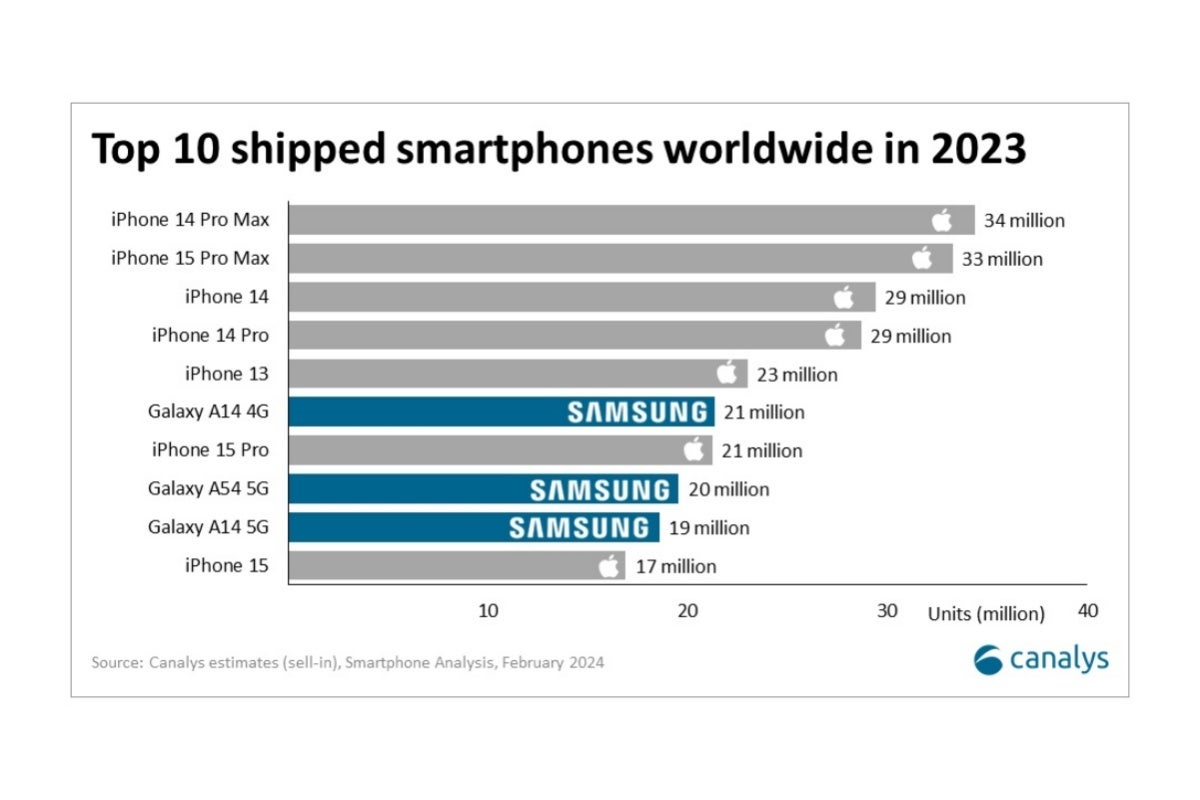Just in case you needed another set of numbers to highlight Apple’s incredible 2023 performance on the global mobile stage, Canalys is now out with its
newest list of the ten top-selling smartphone models around the world.
This one covers the entire last year, showing exactly how the Cupertino-based tech giant managed to defeat Samsung for the first time in history in terms of sales volume (and not just profits) despite continuing to maintain a much “leaner” product portfolio.
The magnificent seven that made the West (and East) tremble
Do you know how many iPhone models Apple officially sells at the time of this writing? The answer might surprise those accustomed to the company’s old ways, as diversity and choice have become more and more important in recent years for Apple’s head honchos (and stockholders).
Between the iPhone 15 and 14 families, the “vanilla” iPhone 13, and the low-cost iPhone SE (2022), there are currently eight different mobile devices you can buy directly from an Apple Store, which explains (at least in part) the presence of no less than seven, count’em, seven iPhones among the ten most successful smartphones of 2023.
Of course, the existence of these products doesn’t automatically guarantee their popularity, with the iPhone 15 Plus, for instance, nowhere to be found on the aforementioned top ten list. Interestingly, said list does include the technically discontinued iPhone 14 Pro while also missing the third-gen iPhone SE.
But the most interesting part of the top ten chart are the names of the two devices at its very peak, both of which end in “Pro Max.” We’re talking about the 2022-released iPhone 14 Pro Max and an iPhone 15 Pro Max blockbuster that needed just a little over three months of commercial availability to reach 33 million unit shipments.
That’s apparently a first that reflects “the market’s premium shift”, as the top-selling smartphone in 2022 was the “regular” iPhone 13 and the non-Pro iPhone 14 had ruled the hierarchy from January through September 2023 (at least according to Counterpoint Research). Holiday shoppers clearly went absolutely berserk for Apple’s biggest and boldest iPhones this time around, sending those profits through the roof.
While the iPhone 14 did manage to edge out its Pro sibling for a spot on the overall podium, the iPhone 15 Pro defeated the “base” iPhone 15 rather comfortably, which suggests next year’s top three could go Pro all the way.
Where is the Galaxy S23 series?
It’s pretty obvious that Samsung has two big challenges to overcome in 2024 if it wants to return in a dominant position in the global smartphone market. The first is that its low to mid-end devices, while wildly popular in their own right, can no longer compete with Apple’s most advanced iPhones in terms of sales volume.
Remember when the entry-level Galaxy A10 was the world’s third best-selling smartphone, closely followed by the A50 and A20? The best Samsung’s Galaxy A-series handsets can do now is occupy sixth place on the above list for 2023, with the A54 5G and A14 5G barely capable of holding off the iPhone 15 while ranking behind the 15 Pro in the ninth and tenth positions respectively.
The Galaxy A54 was Samsung’s second best-selling smartphone of 2023, evidently beating the S23, S23 Plus, and S23 Ultra.
The second and perhaps bigger problem is that all three members of the ultra-high-end Galaxy S23 family proved less popular than the decidedly humble (and affordable) A14 4G, A54 5G, and A14 5G, not to mention the state-of-the-art iPhones they were supposed to take on.
Compared to the iPhone 15 series, these Android heavyweights had seven additional months on the market, but at the end of the day year, that made no difference whatsoever in Samsung’s favor. That’s clearly an extremely poor result for the former global leader of the mobile industry, and the Galaxy S24 lineup will need to greatly improve its predecessor’s sales figures to show (realistic) top ten aspirations this year.






